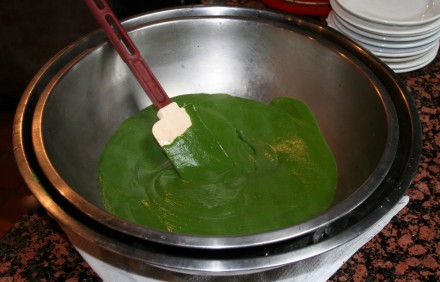 A long time ago I saw an episode of Julie Child’s TV show that I never forgot although I don’t remember it that well either.
A long time ago I saw an episode of Julie Child’s TV show that I never forgot although I don’t remember it that well either.
What I got from it, though, that I’ve never forgotten was that Julia put a lot of time and many ingredients into what ended up being about a half pint of stock she used in her lobster thermidor. I’d thought she’d been making a big pot of soup but in the end she strained and reduced it all down to a single cup of concentrated liquid.
Last week, Tosca’s Executive Chef Kevin Long in Hingham brought me into that world of labor-intensive flavor development.
I had dropped into Long’s kitchen completely unannounced one afternoon last week thinking about greens.
I was thinking about greens because they do better than most vegetables in the cool (ahem) weather that’s dominated most of the season. I was hoping he’d be there and could show me his grilled broccolini or another favorite kale or Swiss chard dish. As it turned out, he was right in the middle of making the spinach puree that he uses, by the spoonful, to flavor the risotto verde he serves with his “costoleta” (cutlet) of pork.
Standing among a group of cooks prepping for dinner, Long pressed the last drops of liquid from a couple cups of compacted spinach in a funnel-shaped colander. This was the remainder of about five pounds of fresh spinach that had been boiled then shocked in ice to retain its color.
“We started with this much,” said one of the cooks with his arms stretched wide like he was describing a redwood tree.
In its reduced, compacted state, the spinach — which looked like a couple green baseballs — was added to a brown lumpy looking concoction Long pulled off the stove. It was a reduction, he said, made with wilted Vidalia onion, cream, natural sugar, whole little Italian peperoncini, (cq) fresh flowering thyme, and roasted garlic cloves. He then put the whole thing into a high-speed blender and ran it for several steamy minutes.
Pouring it into a stainless steel bowl set over a larger bowl filled with ice, Long shocked the spinach a second time to retain its near neon greenness.
The bushelfull of fresh spinach was now reduced down to a few cups of velvety puree that would be used over the next couple of days to flavor risotto.
I tasted a speck and it exploded with light, high, piercing flavor. I could taste sweetness, greenness, and overtones of heat from the little dried red peppers. It was gorgeous.
A cook then handed Long a single serving of risotto in a skillet and the chef added about a tablespoonful of the puree to it. Then he did that commanding and magical mixing action chefs do and the whole dish turned bright green.
“The idea is that in the risotto it blooms,” said Long.
When the chef plated it up inside a drizzle of sweet balsamic vinegar with slices of freshly grilled pork tenderloin on top, we each ate forkfuls from opposite sides of the plate. I had to use great restraint to avoid reaching the middle before he did.
I’d been after a simple recipe for greens, and come away with one in which they play a humble yet vital supporting role in a cast of superstar ingredients.
And there is no play, no movie, no fable without supporting players. They create the context, the interest, the back story — the very flavor — of a piece or a dish.
I am overcome by my awareness of the greatness of greens.